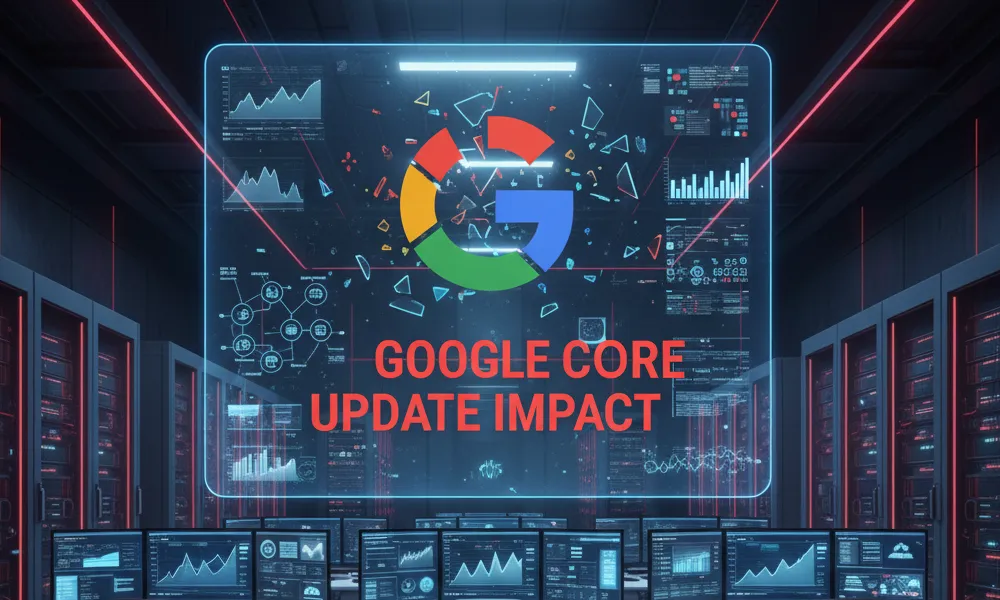A Marketer’s Playbook for Diagnosing & Recovering from a Google Core Update.
It’s a feeling many of us in the digital world know well. You check your analytics on a Monday morning, and your stomach drops. Traffic is down. Rankings have vanished. The stable ground you built your digital strategy on has suddenly given way. This isn’t a glitch; it’s a seismic shift, and it has a name: a Google core update.
These updates aren’t punishments; they are recalibrations. Google is constantly refining its understanding of what is helpful, trustworthy, and valuable. When the algorithm’s perspective shifts, the search results page (SERP) landscape is redrawn. We don’t control the algorithm, but we absolutely control how we respond. Panic is not a strategy. A measured, intelligent response is.
In this playbook, I’ll walk you through the framework we use to navigate these moments of upheaval. We’ll cover:
- The Diagnosis: How to be certain a core update is the cause, not something else.
- The ‘Why’: Decoding what Google is rewarding now.
- The Game Plan: A tactical playbook for a strong recovery.
- The Reality Check: Setting realistic timelines and mindsets.
Think of this as your compass in the storm. It’s built on Google’s own guidance, industry analysis, and the patterns we’ve seen firsthand.
Was It Really a Core Update?
Before you overhaul your entire strategy, you must be sure you’re treating the right problem. A core update has a distinct footprint. Here’s how to identify it.
- The Timing is Unmistakable: The first clue is always timing. Did your sharp, sustained drop in impressions, clicks, and average position begin during or immediately after a confirmed Google core update? Google’s own developers suggest waiting a week after an update finishes rolling out to let the dust settle before drawing firm conclusions. If the dates align, you have your primary suspect.
- The Impact is Broad, Not Isolated: If a single page or a small cluster of keywords tumbles, the cause might be a simple content issue or a new competitor. But when you see a site-wide decline across multiple, unrelated topics and categories, that’s the signature of an algorithmic re-evaluation. Your site as a whole is being assessed differently.
- Your Competitors’ Fortunes Have Changed: Look at the pages that have taken your place. Who won the ground you lost? Analyzing these new top performers is your most valuable source of intel. Are they more comprehensive? Do they demonstrate clearer first-hand experience? Are their sites technically superior? Their success provides a roadmap for what the algorithm is now rewarding.
- The Evidence is in Search Console: Your Google Search Console (GSC) is the scene of the crime. A sustained, deep trough in your impressions graph, coupled with a drop in average position, is the smoking gun. As Google advises, segment your GSC performance report by search type (Web, Images, etc.) to pinpoint where the damage is most severe. A hit in “Web” search is the classic indicator of a core update impact.
What Is Google Rewarding Now?
To recover, you must understand the new rules of the game. While Google keeps its exact formula secret, its announcements and the collective findings of the SEO community point to a clear direction of travel.
- Helpful Content Over SEO-First Content: In its announcement for the August 2024 update, Google was explicit: it wants to show “more content that people find genuinely useful and less content that feels like it was made just to perform well on Search.” The algorithm is getting smarter at distinguishing between content that truly solves a user’s problem and content that just checks off SEO boxes.
- E-E-A-T is Paramount (Especially the First ‘E’): Experience, Expertise, Authoritativeness, and Trustworthiness (E-E-A-T) isn’t just a guideline; it’s the foundation of quality. The recent emphasis on Experience is critical. The algorithm now favors content that demonstrates real, first-hand knowledge. Are you just summarizing what others have said, or are you providing unique insights from your own work? As SEO expert Marie Haynes noted after the June 2025 update, sites that showed deeper author authority and clearer user satisfaction signals were the ones that thrived.
- Technical Excellence is Non-Negotiable: A technically flawless site is the price of admission. Core Web Vitals, mobile usability, and page speed are no longer “nice-to-haves.” They are foundational. We’ve seen pages de-indexed entirely following recent updates, suggesting the algorithm’s filters for technical quality have become much stricter. You can’t afford to have a leaky boat, no matter how great your crew is.
The Recovery Playbook
Reacting hastily is the single biggest mistake you can make. Do not start deleting pages or making frantic, site-wide changes. Recovery is a deliberate process of auditing, strengthening, and iterating.
- Prioritize the Wounded: Use your analytics and GSC to identify the pages that lost the most visibility and traffic. Don’t treat them all equally. Group them by business value, which pages drive revenue, generate leads, or support your brand’s core message? Start there.
- Conduct a Brutally Honest Content Audit: For each high-priority page, ask the tough questions:
- Intent: Does this page truly solve the user’s problem, or does it just talk around it?
- Depth: Is this content shallow, or does it provide comprehensive, detailed answers?
- Originality: Does it offer a unique perspective, data, or experience that can’t be found elsewhere?
- Credibility: Is the author clearly identified as an expert? Are claims backed by data and trusted sources?
- Clarity: Is it well-structured, easy to read, and visually engaging?
- Based on the answers, your path for each page will become clear: either improve it significantly, merge it with another page to create a stronger resource, or retire it if it no longer serves a purpose.
- Systematically Bolster Your E-E-A-T: This is a site-wide initiative.
- Showcase Your Experts: Add detailed author bios with credentials and links to their social profiles or other publications.
- Build Transparency: Make your “About Us,” “Contact,” and “Team” pages robust. Show the real people behind your brand.
- Prove Your Claims: Link out to authoritative sources, cite data, and feature case studies, testimonials, and reviews prominently.
- Learn from the Winners: Go back to the competitors who now outrank you. Deconstruct what they are doing better. Don’t just copy them—aim to exceed their standard. If their article has ten points, can yours have twelve, with better data and a more compelling format?
- Be Patient and Document Everything: Recovery is a marathon, not a sprint. Document every significant change you make and the date you made it. This will allow you to correlate your actions with any positive movement you see in GSC. As Search Engine Journal often reminds us, “Content that was impacted… might not recover—assuming improvements have been made—until the next broad core update is released.” Your hard work today may only be fully rewarded in the next algorithmic wave.
Final Thoughts
A hit from a Google core update feels like a setback, but it’s truly an opportunity. It’s a clear signal from the world’s largest search engine to elevate your standards. It forces you to move beyond simply “doing SEO” and focus on becoming the best, most authoritative, and most helpful resource in your field.
The path forward is about building a stronger, more resilient digital presence—one founded on genuine expertise and a deep commitment to serving your audience. Use this moment to audit, refine, and double down on quality. That is a strategy that will not only help you recover but will also protect you from the seismic shifts of tomorrow.
If you’re navigating this process and need a guide, our tech team at Digital4Africa is here to help chart the course with you. To get help and recover your site from a manual update, get in touch with digital4africa
By Francis Waithaka, CEO, Digital4Africa


